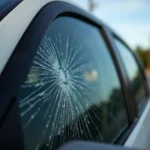Leather car seats are a luxurious and comfortable addition to any vehicle. However, over time, they can become worn, cracked, and faded. Fortunately, you don’t have to live with damaged leather seats. This comprehensive guide will cover everything you need to know about how to repair car leather seats and restore their former glory.
Why Repair Car Leather Seats?
Beyond the aesthetic appeal, there are several practical reasons to repair your car’s leather seats:
- Preserve Resale Value: A car with well-maintained leather seats holds its value significantly better than one with ripped, stained, or faded upholstery.
- Prevent Further Damage: Small cracks and tears can quickly escalate into larger problems if left unaddressed. Repairing them early can save you from needing costly replacements down the line.
- Enhanced Comfort: Worn-out leather can become stiff and uncomfortable. Repairing and conditioning the leather can restore its suppleness and make your rides more enjoyable.
Common Types of Car Leather Seat Damage
Understanding the type of damage your leather seats have sustained is crucial for selecting the right repair methods. Here are some common culprits:
- Cracks: Often caused by age, sun exposure, and lack of conditioning, cracks can range from hairline fractures to deep fissures.
- Tears & Punctures: Sharp objects, pets, and even bulky items can puncture or tear leather seats.
- Scratches & Scuffs: These are often superficial and can be caused by keys, zippers, or rough contact with luggage.
- Fading & Discoloration: Prolonged sun exposure can bleach leather, while spills and stains can leave unsightly marks.
DIY vs. Professional Repair: Which Is Right for You?
While minor scratches and scuffs can often be addressed with DIY leather repair kits, more severe damage like deep cracks, tears, or extensive discoloration is best left to professionals.
DIY Repair Kits:
- Pros: Affordable, readily available, suitable for minor repairs and touch-ups.
- Cons: May not provide lasting results for severe damage, color matching can be tricky, requires some skill and patience.
Check out our article: Can you repair car leather seats?
Professional Leather Repair:
- Pros: Higher quality results, expertise in handling various damage types, access to professional-grade products and color matching techniques.
- Cons: More expensive than DIY kits, may require leaving your car at the shop.
Learn more about the cost: How much to repair leather car seats?
“While DIY kits can be tempting for their affordability, remember that professional leather repair technicians have the experience and knowledge to handle complex repairs and ensure a seamless finish. It’s an investment worth considering for significant damage.” – John Miller, Automotive Upholstery Expert
Essential Tools for Repairing Car Leather Seats
Whether you’re tackling a DIY repair or simply want to understand the process, here are some essential tools used in car leather seat repair:
- Leather Cleaner & Conditioner: Essential for prepping the surface and keeping the leather supple.
- Leather Filler: Used to fill in cracks, tears, and holes.
- Colorant/Dye: Restores the color of faded or discolored leather.
- Applicators: Sponges, brushes, and spray guns for applying various products.
- Heat Gun/Hair Dryer: Helps to speed up drying time and set products.
- Sandpaper (Various Grits): Used for smoothing out filler and creating a seamless surface.
How to Repair Leather Car Seats (Step-by-Step)
Note: This is a general guide, and specific steps may vary depending on the type and severity of the damage.
- Clean the Affected Area: Thoroughly clean the damaged area with a dedicated leather cleaner to remove dirt, grime, and any previous treatments.
- Repair Cracks & Tears: Apply leather filler to any cracks or tears, ensuring it’s level with the surrounding surface. Allow it to dry completely.
- Sand & Smooth: Once the filler is dry, sand the area with progressively finer grits of sandpaper until it’s smooth and flush with the leather.
- Apply Colorant: Using a suitable applicator, apply a color-matched leather dye to the repaired area. Multiple thin coats are better than one thick coat.
- Blend & Finish: Blend the edges of the repaired area with the surrounding leather for a seamless look. Allow the dye to dry completely.
- Condition the Leather: Apply a high-quality leather conditioner to restore the leather’s suppleness and protect it from future damage.
“The key to a successful leather repair lies in the preparation. Taking the time to thoroughly clean and prep the surface ensures optimal adhesion of the filler and dye, resulting in a longer-lasting and more professional-looking repair.” – Maria Sanchez, Automotive Detailing Specialist
Preventing Future Damage: Tips for Keeping Your Leather Seats in Top Condition
- Regular Cleaning: Clean your leather seats regularly with a dedicated leather cleaner to prevent dirt and grime from building up.
- Conditioning: Use a high-quality leather conditioner every few months to keep the leather hydrated and supple.
- Sun Protection: Park your car in the shade or use a windshield sunshade to protect your leather seats from UV damage.
- Prompt Spill Cleanup: Address spills immediately to prevent them from staining the leather.
Frequently Asked Questions (FAQs)
Can I use regular household cleaners on my leather car seats?
No, household cleaners are often too harsh for delicate leather and can cause dryness and damage. Always opt for dedicated leather cleaners.
How often should I condition my leather car seats?
It’s recommended to condition your leather seats every 2-3 months, or more frequently if they are exposed to extreme temperatures or sunlight.
Can I repair leather car seats myself, or should I hire a professional?
Minor scratches and scuffs can often be addressed with DIY kits. However, severe damage like deep cracks, tears, or extensive discoloration is best left to professionals.
Learn more about DIY leather seat repair: How to repair leather seats in car?
How can I prevent my leather car seats from cracking?
Regular cleaning, conditioning, and sun protection are key to preventing cracks. Avoid parking in direct sunlight for extended periods.
What type of leather conditioner is best for car seats?
Look for a high-quality leather conditioner that is specifically designed for automotive leather. Avoid using oil-based conditioners, as they can darken the leather over time.
Conclusion
Repairing your car leather seats is an excellent way to restore your vehicle’s interior, preserve its value, and enhance your driving experience. Whether you opt for a DIY approach or seek professional help, following the tips outlined in this guide can help you bring your leather seats back to life.
Remember, timely repairs and proper maintenance are essential for keeping your car’s interior looking its best for years to come.
Need assistance with repairing your car’s leather seats? Contact our team of experts via WhatsApp: +1(641)206-8880 or email: [email protected]. We’re available 24/7 to answer your questions and provide top-notch support.



